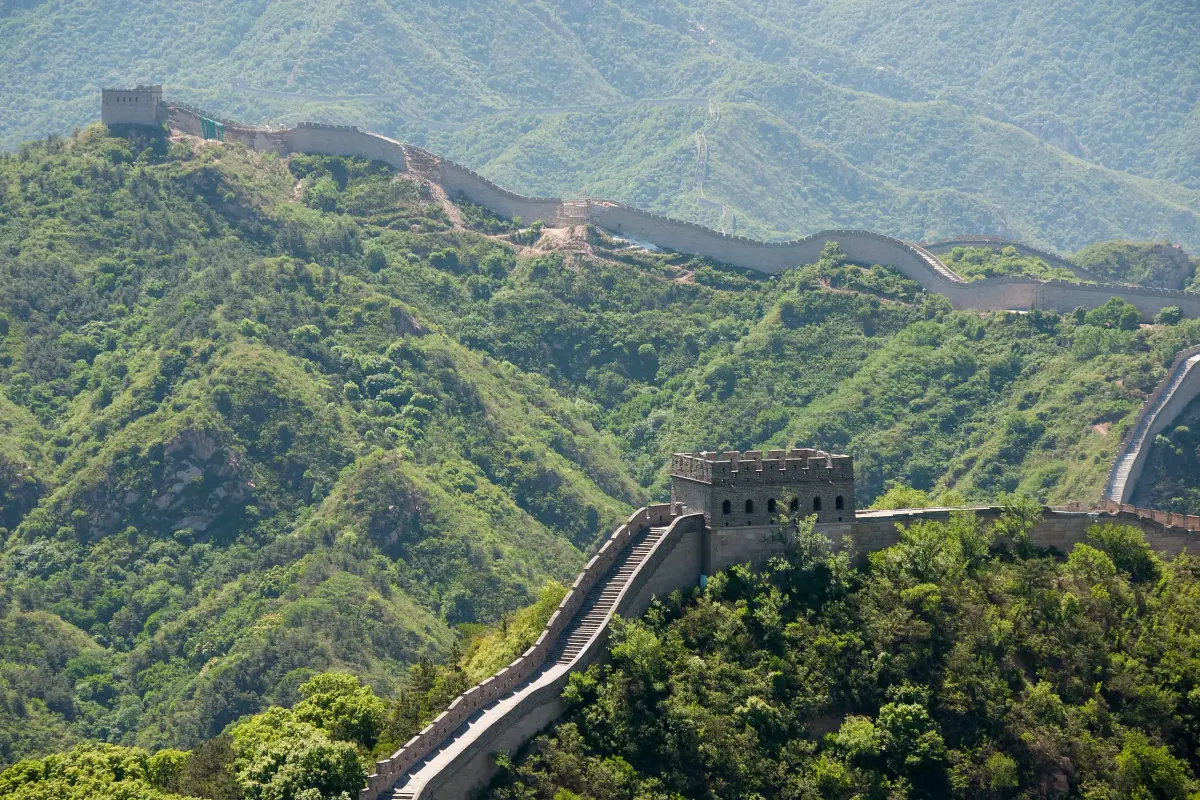History of the Great Wall of China

Image source: Wikimedia Commons
Early Walls (7th Century BC)
The story of the Great Wall of China begins almost 2,700 years ago, during the Spring and Autumn Period (770–476 BC). At that time, China was not a unified country but divided into many smaller kingdoms and states. These states often fought wars against each other, but their greatest threat came from the northern nomadic tribes, especially the Xiongnu and other steppe warriors.
To protect their territories, states such as Chu, Qi, Yan, Wei, Zhao, and Qin began building territorial defensive walls in the 7th century BC. These early walls were not the massive stone structures we imagine today. Instead, they were made of:
- Clay and mud
- Wooden stakes pressed in layers
Even at that time, some walls were over 10 meters high and several meters thick. Although these walls were separate and not connected, they served as the first line of defense for the Chinese states. They:
- Prevented surprise attacks
- Slowed enemy cavalry
- Gave soldiers time to prepare for counterattacks
Archaeological remains of these early walls can still be found in Hebei, Shandong, and Henan provinces. Thus, the 7th-century BC walls laid the foundation for the idea of a "Great Wall" – a continuous barrier that could protect the Chinese heartland for centuries to come.

Contributions of the Qin Dynasty (221–206 BC)
The true beginning of the Great Wall as a unified structure came during the Qin Dynasty under the reign of Qin Shi Huang, the first emperor of China. In 221 BC, Qin Shi Huang successfully unified all the warring states into one empire. This was a turning point in Chinese history, but it also posed new security challenges.
From the northern steppes, the Xiongnu Confederation and other tribes continuously endangered the stability of the realm. To protect the new empire, Qin Shi Huang ordered the previously fragmented state walls to be connected into a continuous defense system. It marked the earliest realization of what could genuinely be called a “Great Wall.”
Construction was extremely laborious:
- Around one million workers—including farmers, troops, and prisoners—took part.
- Many died from exhaustion, hunger, and brutal conditions.
- This is why many describe the Wall as the “largest cemetery ever known.”
The wall built under the Qin extended beyond 5,000 km and was mainly composed of mud-based bricks. Unlike the later Ming Wall, it was not strong enough to withstand centuries of erosion, so today only traces remain in Gansu and Inner Mongolia.
However, Qin Shi Huang's vision was revolutionary. For the first time in history, China had a single, unified defense line along its northern border. In this way, the Great Wall came to be recognized as a national endeavor of China.

Image source: Wikimedia Commons

Image source: Wikimedia Commons
Ming Dynasty Reconstruction (1368–1644 AD)
The era of the Ming rulers (1368–1644 AD) is often regarded as the most flourishing phase in the history of the Great Wall. By this time, the earlier walls built during the Qin and Han dynasties were mostly ruined and decayed. New threats from the Mongols—especially after the fall of the Yuan Dynasty—forced the Ming emperors to build a stronger, more permanent wall.
Unlike earlier walls made of mud bricks, Ming builders used:
- Stone blocks
- Bricks
- Lime mortar
This construction method made the wall much stronger, allowing it to survive centuries of erosion. The Ming Great Wall stretched for more than 8,800 km (5,500 miles), winding through mountains, deserts, and grasslands.
Innovations of the Ming Wall
- Watchtowers at regular intervals for communication and signaling
- Forts and barracks to house soldiers
- Beacon towers relayed messages of enemy movement using flames and smoke
- Double and triple walls in key areas for extra security
The famous tourist sections of the Great Wall today, such as Badaling, Mutianyu, Jinshanling, and Simatai, were all built during the Ming Dynasty. These represent the iconic image of the Great Wall, with its vast stone steps and breathtaking mountain views.
The Ming emperors stationed millions of soldiers on the wall, creating one of the most sophisticated border defense systems in the world.
Fall of the Qing Dynasty (After 1644)
In 1644 AD, the Ming Dynasty fell, and the Qing Dynasty (ruled by the Manchus from northeastern China) came to power. Unlike the Ming, the Qing rulers were not threatened by northern nomads—because they themselves came from the north. Their empire expanded greatly into Mongolia, Tibet, and Central Asia, so the Great Wall lost its strategic importance.
The Qing emperors preferred diplomatic and military campaigns outside the Wall rather than relying on static defenses. As a result:
- Maintenance of the Wall declined
- Troops were withdrawn
- Watchtowers and forts were abandoned
Over the centuries, large parts of the wall fell into ruin. Farmers reused stones and bricks for houses and roads. Only the Ming-era sections near Beijing remained well-preserved, mainly because they were close to the capital and symbolized imperial power.
By the 19th century, the Great Wall was no longer a military defense system but had already become a symbol of Chinese history, culture, and endurance.
The Great Wall in Modern Times
Today, the Great Wall of China is not just a ruin of ancient battles—it is one of the Seven Wonders of the Medieval World and a UNESCO World Heritage Site (1987). Millions of tourists visit every year to walk its steps, admire its breathtaking views, and feel the weight of centuries of history.
Although many parts are in ruins, the preserved sections near Beijing have made the wall a global symbol of China’s strength, resilience, and unity.
It is often said: “The Great Wall is more than a physical barrier; it reflects the cultural spirit and determination of China.”

